Haras de la Vendée is a Stud Farm built in 1843 at the request of King Louis Philippe. At that time, most of the stud farms were former monastic buildings converted during the French Revolution. The Haras de la Vendée, however, was meant to be a stud farm from the very beginning.
The right side of this building is where the stallions are housed.
There are 21 National stud farms in France. This one was bought by the Conseil Général de la Vendée in 2006. It has now become the only departmental stud farm in France keeping National Stallions, developing cultural and touristic activities, and taking part in breeding associations. A school for show horses was also created here.
This portion of the building houses the mares.
The stud farm was built during the industrial revolution and the aim was to be able to keep as many horses as possible. Hence, the linear architecture.
Our guide, Périne, giving us a 45 minute private tour. We must have arrived before the crowds!
The inside of the building where the mares are housed.
Horses' rations are adapted to their weight and work, from 2/3 to 2 gallons. They are fed with hay twice a day (11 pounds per horse). Horses drink between 11 and 14 gallons of water each day, and the volume can easily double in summer. The stalls are equipped with automatic drinking troughs.
The top window is where the hay is brought in and stored in the loft.
There are 30 full-time year-round staff, with an extra 10 during the summer months.
If I don't move... no one will notice that I've escaped my stall.
So gentle. Taking hay from a little girl's hand.
A wisteria pod definitely feels like this muzzle.
This horse was so funny, we thought he could talk. He kept pointing to the hay bale with his head, nodding vigorously and almost requesting in words that he wanted some! When we didn't respond, he stomped his hooves in a tantrum!
***
We took a little buggy ride throughout the grounds, using a very peaceful and shady lane. The driver (we can only see his arm here) knew Vancouver well. He had worked with Cavalia. He said there was a lot of French spoken with that group (not surprising since it comes from Montreal), but I didn't get the sense he had enjoyed Vancouver that much. Too big of a city and too much noise for someone used to this quiet environment.
***
A large centre displaying very old carriages used throughout the century.
***
We then entered the old forge where the tools used for shoeing horses are still where they were last placed. There must be a working forge elsewhere where the horses are currently being shod because this one is very much like a museum.
This horseshoe is for a front hoof because it has one elevated edge in the middle. (It's hard to see because it's in shadow, touching our guide's hand.) When there are two, at the "10 and 2 o'clock" positions, that shoe is for a rear hoof.
Various horseshoe sizes.
A horse's hoof is made of horn which continually grows, almost 1" per month. It is very fragile and can easily get damaged or broken if not protected by a horseshoe, which would make the horse lame and therefore unusable.
Where the shoe sits and where the nails are pounded in, that is all horn, like our fingernails. The only sensation the horse feels is in the middle of the hoof.
.
Different sized nails, depending on the shoe and the size of the horse.
All the tools required to do the job.
Real bones from a horse. Very interesting anatomy lesson.
For shoeing workhorses, the farrier uses what is called a "work". The leather shackles hold the horse's hooves, and the belt is put under its belly for support in case the horse feels tired being on three legs and needs a little rest. The farrier's hands are free and he can shoe the horse without having to carry its weight, some horses weighing 1900 lbs.
The English way of shoeing a horse is with one person, the farrier, holding the horse's foot between his thighs and working with both his hands.
The French way involves two people, one to hold the horse's foot, and the other to shoe it.
Shoeing four hooves takes about an hour and a half.
***
There is an insemination lab. We visited where the semen is collected in the breeding program although this was not the lab that is being used today. It was interesting to see the "fake mare" with an artificial vagina. It is just the right height but made of wood and padding. There are stairs on one side of this fake mare where the breeder can harvest the semen through piping. The semen is diluted in the lab and is either frozen, refrigerated or used fresh for a mare that is on the premises.
The main advantage of this technique is that it enables stallions to cover from 15 - 65 mares anywhere in the country and to carry on with their show or sport career.
***
This is the Baudet de Poitou, a breed of donkey originating in the Poitou region of France. It is one of the most distinctive donkey breeds and also among the rarest and least known.
It is instantly recognizable because of its shaggy coat, called a "cadanette". It hangs in long cords or shaggy hanks when ungroomed because the hair is longer and softer than that of other breeds of donkeys.
***
There are little demonstrations or information sessions throughout the day. This one was how to saddle a horse. The rider is adjusting her chaps which only go from boot to knee. The western-style chaps that cowboys wear look very different.
She uses a chair to get up on the horse because she does this many times a day and does not want to hurt the horse's spinal cord.
***
We attended two shows that demonstrated the horses performing in shows like Cavalia. The first show was how they are trained.
The horse on a lead.
How it takes a command without even being touched. The horse is never hurt and is trained through positive reinforcement.
The horse is never asked to perform a movement that is not in its nature.
The demonstration show ended with the horse stealing the trainer's hat.
***
The next session we attended was a presentation of the various horse breeds found on this stud farm. We were introduced to their characteristics and what the "stud book" demands when breeding.
We saw Criollo, Spanish or Portuguese; the Barb, developed on the Barbary Coast of North Africa; the Miniature Horse, which are NOT small ponies; Selle Français, France's most important sports horse; Normandy Cob, the Anglo-Norman horse breed developed from the Thoroughbreds and heavy horses from Normandy; Friesian, (also Frisian), a breed originating in the Netherlands; and the Shetland pony, originating in the Shetland Isles, northeast of mainland Scotland.
Not the same black horse as the one above. Look at the legs and the hairy ankles on the first.
***
Ahhh...
THE END
***`
"There is a spirit that pervades everything, that is capable of powerful song and radiant movement, and that moves in and out of the mind.
The colours of this spirit are multitudinous, a glowing, pulsing rainbow."
~ Paula Gunn Allen

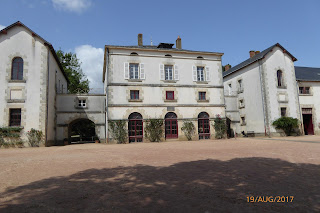



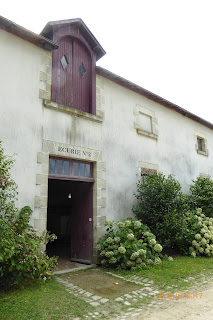


































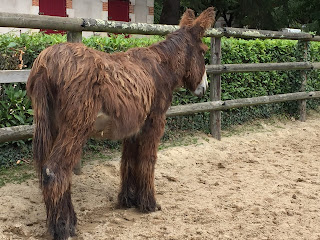



















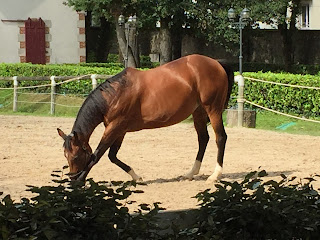







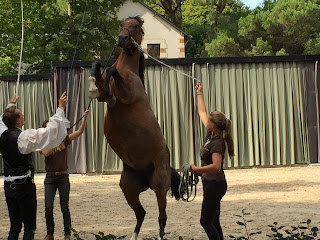










Gorgeous and happy horses, love the little horse that has the temper tantrums lol! I'm always a bit squeamish with the process of applying horseshoes, as always feel it must hurt them. Good to know it does not. How do wild horses go without horseshoes, they must feel a lot of pain.
ReplyDeleteGreat question about the wild horses! But I do know that there is no pain in shoeing a horse if it's done right.
Delete